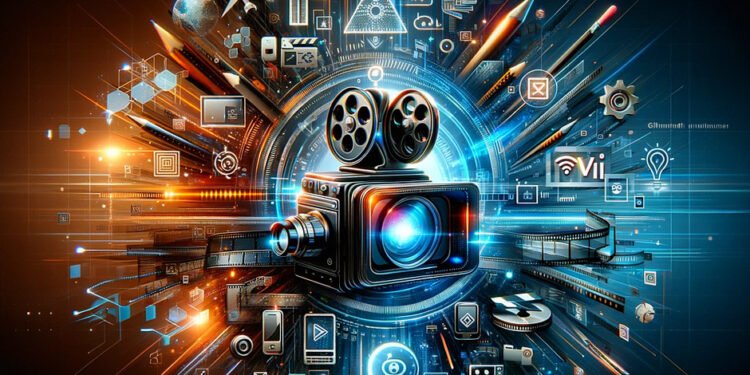In today’s fast-paced digital era, video content is more than a tool for entertainment—it’s a dominant medium for communication, marketing, and education. As the demand for high-quality videos grows, so does the need for tools that streamline the creation process. Enter AI-powered video editing technologies, which have transformed how creators conceptualize, produce, and deliver content. These innovative tools are reshaping the content creation landscape by automating complex tasks, enhancing creativity, and making professional-grade editing accessible to everyone.
The Evolution of Video Editing
Traditionally, video editing was a labor-intensive process that required a deep understanding of software, significant time investments, and technical expertise. From organizing footage to adding effects, the process demanded meticulous attention to detail. While manual editing still has its place, advancements in artificial intelligence (AI) have ushered in a new era of efficiency and creativity.
AI has shifted video editing from a static, time-consuming task to a dynamic, intuitive process. With features such as automated clip organization, color correction, and intelligent scene transitions, AI has enabled creators to focus on the storytelling aspect rather than getting bogged down in the technicalities.
How AI Video Editors Are Transforming Content Creation
AI video editors bring a host of benefits to content creators, from professionals to hobbyists. Here are some of the key ways they are revolutionizing the field:
1. Automation of Repetitive Tasks
One of the most time-consuming aspects of video editing is organizing and cutting raw footage. AI tools can analyze hours of video content, identify the most relevant scenes, and piece them together in a coherent sequence. This automated functionality eliminates repetitive tasks, allowing creators to spend more time refining their narratives.
AI can also handle tasks such as synchronizing audio with visuals, removing background noise, and stabilizing shaky footage—all essential components of producing polished videos.
2. Enhanced Creativity Through Smart Suggestions
AI video editing tools are equipped with intelligent algorithms that suggest creative edits based on the content. For instance, they can recommend transitions, apply filters, or even adjust pacing to match the mood of the video. This feature is particularly beneficial for creators who may not have a background in editing, enabling them to produce professional-quality content effortlessly.
3. Personalization at Scale
For businesses and marketers, AI video editing tools are invaluable for creating personalized content at scale. AI can tailor videos to specific audiences by automatically adding localized text, subtitles, or voiceovers. This capability ensures that brands can connect with diverse demographics without the need for extensive manual intervention.
4. Real-Time Editing Capabilities
With advancements in AI, real-time editing is becoming a reality. Live events, webinars, or vlogs can now be edited and enhanced as they happen. AI-powered tools can detect key moments during a live recording, highlight them, and prepare the final cut within minutes of the event concluding.
Making Video Editing Accessible
One of the most significant impacts of AI video editors is their ability to democratize video production. Previously, creating high-quality videos required expensive software and technical expertise. Today, AI-powered tools offer intuitive interfaces and automated features that cater to users with minimal editing knowledge.
For instance, an AI video app can guide users through the editing process, enabling them to create engaging content directly from their smartphones. These apps are particularly beneficial for small businesses, social media influencers, and educators who need quick, impactful videos but lack the resources for professional editing services.
AI’s Role in Enhancing Storytelling
At its core, video editing is about storytelling. AI enhances this aspect by offering tools that help creators craft compelling narratives. Through emotion detection and content analysis, AI can identify the most impactful moments in a video and highlight them effectively.
For example, AI algorithms can analyze facial expressions, tone, and context within video clips to determine the emotional tone. Based on this analysis, the editor can suggest music, pacing adjustments, or even camera effects that align with the desired emotional impact.
Applications Across Industries
The rise of AI video editors has sparked innovation across various industries.
- Marketing and Advertising: Brands leverage AI to produce tailored video campaigns that resonate with specific audiences. AI’s ability to analyze consumer behavior ensures that the right message reaches the right audience.
- Education: Educators are using AI to create engaging learning materials. By automating video production, teachers can focus on content creation, ensuring students receive high-quality, interactive resources.
- Entertainment: Filmmakers and content creators are exploring AI-driven editing for quick turnarounds without compromising on quality. AI is also helping creators experiment with new visual effects and cinematic techniques.
- Healthcare: Medical professionals use AI-powered video editing to create instructional materials and patient education videos, streamlining communication and enhancing learning outcomes.
Challenges and Ethical Considerations
While AI video editing offers numerous advantages, it’s not without challenges. Concerns surrounding data privacy, content authenticity, and the potential loss of creative control are key issues that need addressing.
- Data Privacy: AI tools often require access to large amounts of user data, raising questions about how this information is stored and used.
- Authenticity: As AI becomes more sophisticated, the line between genuine and manipulated content may blur. Ensuring transparency in AI-edited videos is crucial for maintaining trust.
- Creative Autonomy: While AI can assist in the creative process, over-reliance on automation may limit originality. Striking a balance between AI’s capabilities and human creativity is essential.
The Future of AI in Video Editing
The future of AI video editors is bright, with ongoing advancements promising even more innovative features. From AI-driven storyboarding to fully automated post-production pipelines, the possibilities are vast.
Emerging technologies such as augmented reality (AR) and virtual reality (VR) will further expand AI’s role in video editing, enabling creators to craft immersive content that captivates audiences in new and exciting ways.
Moreover, as AI continues to integrate with other technologies, such as natural language processing and sentiment analysis, video editors will gain even deeper insights into audience preferences, allowing for hyper-personalized content creation.
Conclusion
AI video editors are redefining the content creation landscape, offering tools that empower users to produce high-quality videos efficiently and creatively. By automating repetitive tasks, enhancing storytelling, and democratizing access to professional editing features, AI is enabling creators to focus on what matters most—bringing their ideas to life. As these technologies evolve, they will continue to unlock new possibilities, revolutionizing how we create and consume video content in the digital age.












